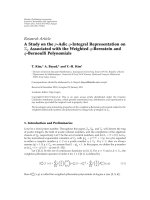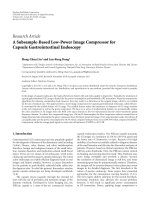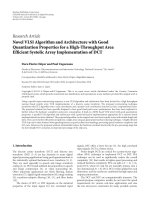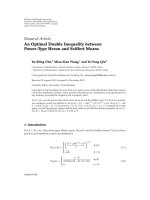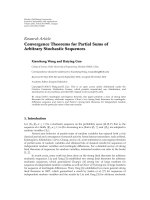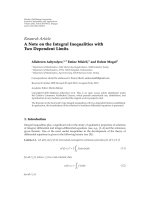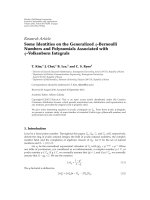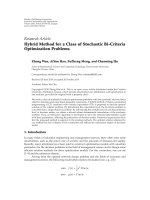báo cáo hóa học:" Research Article Biorthogonal Systems Approximating the Solution of the Nonlinear Volterra Integro-Differential Equation" doc
Bạn đang xem bản rút gọn của tài liệu. Xem và tải ngay bản đầy đủ của tài liệu tại đây (487.7 KB, 9 trang )
Hindawi Publishing Corporation
Fixed Point Theory and Applications
Volume 2010, Article ID 470149, 9 pages
doi:10.1155/2010/470149
Research Article
Biorthogonal Systems Approximating
the Solution of the Nonlinear Volterra
Integro-Differential Equation
M. I. Berenguer, A. I. Garralda-Guillem, and M. Ruiz Gal
´
an
Departamento de Matem
´
atica Aplicada, Escuela Universitaria de Arquitectura T
´
ecnica,
Universidad de Granada, 18071 Granada, Spain
Correspondence should be addressed to M. Ruiz Gal
´
an,
Received 22 March 2010; Accepted 14 June 2010
Academic Editor: Juan J. Nieto
Copyright q 2010 M. I. Berenguer et al. This is an open access article distributed under the
Creative Commons Attribution License, which permits unrestricted use, distribution, and
reproduction in any medium, provided the original work is properly cited.
This paper deals with obtaining a numerical method in order to approximate the solution of
the nonlinear Volterra integro-differential equation. We define, following a fixed-point approach,
a sequence of functions which approximate the solution of this type of equation, due to some
properties of certain biorthogonal systems for the Banach spaces C0, 1 and C0, 1
2
.
1. Introduction
The aim of this paper is to introduce a numerical method to approximate the solution of the
nonlinear Volterra integro-differential equation, which generalizes that developed in 1.Let
us consider the nonlinear Volterra integro-differential equation
y
t
f
t, y
t
t
0
K
t, s, y
s
ds
t ∈
0, 1
,
y
0
y
0
,
1.1
where y
0
∈ R and K : 0, 1 × 0, 1 × R → R and f : 0, 1 × R → R are continuous functions
satisfying a Lipschitz condition with respect to the last variables: there exist L
f
,L
K
≥ 0 such
2 Fixed Point Theory and Applications
that
f
t, y
1
− f
t, y
2
≤ L
f
y
1
− y
2
,
K
t, s, y
1
− K
t, s, y
2
≤ L
K
y
1
− y
2
,
1.2
for t, s ∈ 0, 1 and for y
1
,y
2
∈ R. In the sequel, these conditions will be assumed. It is a simple
matter to check that a function z : 0, 1 → R is a solution of 1.1 if, and only if, it is a fixed
point of the self-operator of the Banach space C0, 1usual supnorm T : C0, 1 → C0, 1
given by the formula
Ty
t
y
0
t
0
f
v, y
v
dv
t
0
v
0
K
v, s, y
s
ds dv. 1.3
Section 2 shows that operator T satisfies the hypothesis of the Banach fixed point
theorem and thus the sequence {T
m
z
0
}
m∈N
converges to the solution z of 1.1 for any
z
0
∈ C0, 1. However, such a sequence cannot be determined in an explicit way. The
method we present consists of replacing the first element of the convergent sequence, Tz
0
,
by the new easy to calculate function z
1
∈ C0, 1, and in such a way that the error
Tz
0
− z
1
is small enough. By repeating the same process for the function Tz
1
and so
on, we obtain a sequence {z
m
}
m≥0
that approximates the solution z of 1.1 in the uniform
sense. To obtain such sequence, we will make use of some biorthogonal systems, the usual
Schauder bases for the spaces C0, 1 and C0, 1
2
, as well as their properties. These questions
are also reviewed in Section 2.InSection3 we define the sequence {z
m
}
m∈N
described
above and we study the error z − z
k
. Finally, in Section 4 we apply the method to two
examples.
Volterra integro-differential equations are usually difficult to solve in an analytical
way. Many authors have paid attention to their study and numerical treatment see for
instance 2–15 for the classical methods and recent results. Among the main advantages
of our numerical method as opposed to the classical ones, such as collocation or quadrature,
we can point out that it is not necessary to solve algebraic equation systems; furthermore,
the integrals involved are immediate and therefore we do not have to require any quadrature
method to calculate them. Let us point out that our method clearly applies to the case where
the involved functions are defined in t
0
, T, although we have chosen the unit interval for
the sake of simplicity. Schauder bases have been used in order to solve numerically some
differential and integral problems see 1, 16–20.
2. Preliminaries
We first show that operator T
n
also satisfies a suitable Lipschitz condition. This result is
proven by using an inductive argument. The proof is similar to that of the linear case see
1, Lemma 2.
Fixed Point Theory and Applications 3
Lemma 2.1. For any p, q ∈ C0, 1 and n ∈ N, we have
T
n
p − T
n
q
≤
L
n
n!
p − q
,
2.1
where L : L
f
L
K
.
In view of the Banach fixed point theorem and Lemma 2.1, T has a unique fixed point
z and
for all z
0
∈ C
0, 1
and m ≥ 1, z − T
m
z
0
≤
∞
km
L
k
k!
Tz
0
− z
0
.
2.2
Now let us consider a special kind of biorthogonal system for a Banach space. Let
us recall that a sequence {b
n
}
n≥1
in a Banach space E is said to be a Schauder basis if for
every x ∈ E there exists a unique sequence of scalars {β
n
}
n≥1
such that x
n≥1
β
n
b
n
. The
associated sequence of continuous and linear projections {P
n
}
n≥1
is defined by the partial
sums P
n
k≥1
β
k
b
k
n
k1
β
k
b
k
. We now consider the usual Schauder basis for the space
C0, 1supnorm, also known as the Faber-Schauder basis: for a dense sequence of distinct
points {t
i
}
i≥1
, with t
1
0andt
2
1, we define b
1
t : 1, t ∈ 0, 1 and for all n ≥ 2we
use b
n
to stand for the piecewise linear function with nodes at the points {t
1
, ,t
n
} with
b
n
t
k
0 for all k<nand b
n
t
n
1. It is straightforward to show see 21 that the
sequence of projections {P
n
}
n≥1
satisfies the following interpolation property:
x ∈ C
0, 1
,n≥ 1,i≤ n ⇒ P
n
x
t
i
x
t
i
. 2.3
In order to define an analogous basis for the Banach space C0, 1
2
supnorm, let us consider
the mapping σ : N → N × N given by for a real number x, x denotes its integer part
σ
n
:
⎧
⎪
⎪
⎪
⎪
⎨
⎪
⎪
⎪
⎪
⎩
√
n,
√
n
if
√
n
√
n,
n −
√
n
2
,
√
n
1
if 0 <n−
√
n
2
≤
√
n
,
√
n
1,n−
√
n
2
−
√
n
if
√
n
<n−
√
n
2
.
2.4
If {b
i
}
i≥1
is a Schauder base for the space C0, 1, then the sequence
B
n
s, t
: b
i
s
b
j
t
s, t ∈
0, 1
, 2.5
with σni, j, is a Schauder basis for C0, 1
2
see 21. Therefore, from now on, if
{t
i
: i ≥ 1} is a dense subset of distinct points in 0, 1,witht
1
0andt
2
1, and {b
i
}
i≥1
is the
associated usual Schauder basis, then we will write {B
n
}
n≥1
to denote the Schauder basis for
C0, 1
2
obtained in this “natural” way. It is not difficult to check that this basis satisfies similar
4 Fixed Point Theory and Applications
properties to the ones for the one-dimensional case: for instance, the sequence of projections
{Q
n
}
n≥1
satisfies, for all x ∈ C0, 1
2
and for all n, i, j ∈ N with σ
−1
i, j ≤ n,
Q
n
x
t
i
,t
j
x
t
i
,t
j
. 2.6
Under certain weak conditions, we can estimate the rate of convergence of the sequence of
projections. For this purpose, consider the dense subset {t
i
}
i≥1
of distinct points in 0, 1 and
let T
n
be the set {t
1
, ,t
n
} ordered in an increasing way for n ≥ 2. Clearly, T
n
is a partition
of 0, 1.LetΔT
n
denote the norm of the partition T
n
. The following remarks follow easily
from the interpolating properties 2.3 and 2.6 and the mean-value theorems for one and
two variables:
x ∈ C
1
0, 1
,n≥ 2 ⇒
x − P
n
x
≤ 2
x
ΔT
n
,
2.7
x ∈ C
1
0, 1
2
,n≥ 2 ⇒x − Q
n
2
x
≤4 max
∂x
∂s
,
∂x
∂t
ΔT
n
.
2.8
3. A Method for Approximating the Solution
We now turn to the main purpose of this paper, that is, to approximate the unique fixed point
of the nonlinear operator T : C0, 1 → C0, 1 given by 1.3, with the adequate conditions.
We then define the approximating sequence described in the Introduction.
Theorem 3.1. Let K ∈ C
1
0, 1
2
× R,f ∈ C
1
0, 1 × R,z
0
∈ C
1
0, 1, and m ∈ N.
Let {ε
1
, ,ε
m
} be a set of positive numbers and, with the notation above, define inductively, for
k ∈{1, ,m} and 0 ≤ t, s ≤ 1, the functions
Ψ
k−1
t
: f
t, z
k−1
t
,
Φ
k−1
t, s
: K
t, s, z
k−1
s
,
3.1
z
k
t
: y
0
t
0
P
m
k
Ψ
k−1
v
dv
t
0
v
0
Q
n
k
2
Φ
k−1
v, s
ds dv,
3.2
where
1 m
k
is a natural number such that ΔT
m
k
≤
ε
k
4Ψ
k−1
2 n
k
is a natural number such that ΔT
n
k
≤
ε
k
4M
k−1
, with
M
k−1
: max
∂Φ
k−1
∂t
,
∂Φ
k−1
∂s
.
3.3
Then, for all k ∈{1, ,m}, it is satisfied that
Tz
k−1
− z
k
≤ε
k
. 3.4
Fixed Point Theory and Applications 5
Proof. In view of condition 1 we have, by applying 2.7, that for all k ∈{1, ,m},the
inequality
Ψ
k−1
− P
m
k−1
Ψ
k−1
≤
ε
k
2
.
3.5
is valid. Analogously, it follows from condition 2 and 2.8 that for all k ∈{1, ,m}
Φ
k−1
− Q
m
2
k−1
Φ
k−1
≤ε
k
.
3.6
As a consequence, we derive that for all t ∈ 0, 1 we have
|
Tz
k−1
t
− z
k
t
|
≤
t
0
Ψ
k−1
v
− P
m
k−1
Ψ
k−1
v
dv
t
0
v
0
Φ
k−1
v, s
− Q
m
2
k−1
Φ
k−1
v, s
ds dv
≤
ε
k
2
ε
k
t
0
v
0
ds dv
ε
k
,
3.7
and therefore,
Tz
k−1
− z
k
≤ ε
k
3.8
as announced.
The next result is used in order to establish the fact that the sequence defined in
Theorem 3.1 approximates the solution of the nonlinear Volterra integro-differential equation,
as well as giving an upper bond of the error committed.
Proposition 3.2. Let m ∈ N and {z
0
,z
1
, ,z
m
} be any subset of C0, 1. Then
z − z
m
≤
∞
km
L
k
k!
Tz
0
− z
0
m
k1
L
m−k
m − k
!
Tz
k−1
− z
k
,
3.9
with z being the fixed point of the operator T and L L
f
L
K
.
Proof. We know from Lemma 2.1 that
T
m−k1
z
k−1
− T
m−k
z
k
≤
L
m−k
m − k
!
Tz
k−1
− z
k
3.10
6 Fixed Point Theory and Applications
for k ∈{1, ,m}, which implies
m
k1
T
m−k1
z
k−1
− T
m−k
z
k
≤
m
k1
L
m−k
m − k
!
Tz
k−1
− z
k
.
3.11
The proof is complete by applying 2.2 to z − T
m
z
0
and taking into account that
z − z
m
≤
z − T
m
z
0
m
k1
T
m−k1
z
k−1
− T
m−k
z
k
.
3.12
As a consequence of Theorem 3.1 and Proposition 3.2,ifz is the exact solution of the
nonlinear Volterra integro-differential 1.1, then for the sequence of approximating functions
{z
m
}
m≥0
the error z − z
m
is given by
z − z
m
≤
∞
km
L
k
k!
Tz
0
− z
0
m
k1
L
m−k
m − k
!
ε
k
,
3.13
where L L
f
L
K
. In particular, it follows from this inequality that given ε>0, there exists
m ≥ 1 such that z − z
m
<ε.
In order to choose m
k
and n
k
projections P
m
k
and Q
n
2
k
in Theorem 3.1, we can observe
the fact, which is not difficult to check, that the sequences {Ψ
k
}
k≥0
and {M
k
}
k≥0
are bounded
and hence conditions 1.1 and 1.3 in Theorem 3.1 are easy to verify, provided that the
scalar sequence {ε
k
}
k≥1
is bounded, f and K are C
1
−functions, and ∂f/∂t, ∂f/∂s, ∂K/∂t,
∂K/∂s, and ∂K/∂u satisfy a Lipschitz condition at their last variables. Indeed in view of
inequality 3.13,
z − z
k
≤ e
L
Tz
0
− z
0
sup
k≥1
ε
k
, 3.14
and in particular {z
k
}
k≥0
is bounded. Therefore, taking into account that the Schauder bases
considered are monotone norm-one projections, see 21, we arrive at
z
k
≤ max
t∈
0,1
f
t, z
k−1
t
max
t,s∈
0,1
|
K
t, s, z
k−1
s
|
.
3.15
Take M
f
: max
0≤t≤1
|ft, 0| and M
K
: max
0≤t,s≤1
|Kt, s, 0| to derive from the triangle
inequality and the last inequality that
z
k
≤ L
f
z
k−1
M
f
L
K
z
k−1
M
K
. 3.16
Finally, since the sequence {z
k
}
k≥0
is bounded, {z
k
}
k≥0
also is. Similarly, one proves
that {Ψ
k
}
k≥1
is bounded sequences {z
k
}
k≥0
and {z
k
}
k≥0
are bounded and ∂f/∂t and ∂f/∂s
are Lipschitz at their second variables and {M
k
}
k≥1
is bounded sequences {z
k
}
k≥0
and
{z
k
}
k≥0
are bounded and ∂K/∂t, ∂K/∂s, and ∂K/∂s are Lipschitz at the third variables.
Fixed Point Theory and Applications 7
We have chosen the Schauder bases above for simplicity in the exposition, although
our numerical method also works by considering fundamental biorthogonal systems in
C0, 1 and C0, 1
2
.
4. Numerical Examples
The behaviour of the numerical method introduced above will be illustrated with the
following two examples.
Example 4.1. 22, Problem 2. The equation
y
t
2t −
1
2
sin
t
4
t
0
t
2
s cos
t
2
y
s
ds
t ∈
0, 1
,
y
0
0
4.1
has exact solution ztt
2
.
Example 4.2. Consider the equation
y
t
3t
2
1
3
cos
y
t
− 1
t
0
s
2
sin
y
s
ds
t ∈
0, 1
,
y
0
0
4.2
whose exact solution is ztt
3
.
The computations associated with the examples were performed using Mathematica
7. In both cases, we choose the dense subset of 0, 1
0, 1,
1
2
,
1
4
,
3
4
, ,
1
2
k
,
3
2
k
, ,
2
k
− 1
2
k
,
4.3
to construct the Schauder bases in C0, 1 and C0, 1
2
. To define the sequence {z
m
}
m∈N
introduced in Theorem 3.1, we take z
0
ty
0
and m
k
n
k
j for all k ∈ N in the expression
3.2,thatis
z
k
t
y
0
t
0
P
j
Ψ
k−1
v
dv
t
0
v
0
Q
j
2
Φ
k−1
v, s
ds dv.
4.4
In Tables 1 and 2 we exhibit, for j 9, 17 and 33, the absolute errors committed in eight
points t
i
of 0, 1 when we approximate the exact solution z by the iteration z
m
.Theresults
in Table 1 improve those in 22.
8 Fixed Point Theory and Applications
Table 1: Absolute errors for Example 4.1.
j 9 j 17 j 33
t
i
|z
3
t
i
− zt
i
||z
3
t
i
− zt
i
||z
3
t
i
− zt
i
|
0.125 3.81 × 10
−6
1.03 × 10
−6
2.63 × 10
−7
0.250 3.30 × 10
−5
8.42 × 10
−6
2.11 × 10
−6
0.375 1.13 × 10
−4
2.85 × 10
−5
7.14 × 10
−6
0.52.69 × 10
−4
6.76 × 10
−5
1.69 × 10
−5
0.625 5.24 × 10
−4
1.31 × 10
−4
3.28 × 10
−5
0.750 8.85 × 10
−4
2.21 × 10
−4
5.53 × 10
−5
0.875 1.30 × 10
−3
3.23 × 10
−4
8.07 × 10
−5
11.52 × 10
−3
3.75 × 10
−4
9.36 × 10
−5
Table 2: Absolute errors for Example 4.2.
j 9 j 17 j 33
t
i
|z
2
t
i
− zt
i
||z
2
t
i
− zt
i
||z
2
t
i
− zt
i
|
0.125 9.76 × 10
−4
2.44 × 10
−4
6.10 × 10
−5
0.250 1.95 × 10
−3
4.88 × 10
−4
1.22 × 10
−4
0.375 2.92 × 10
−3
7.32 × 10
−4
1.83 × 10
−4
0.53.90 × 10
−3
9.75 × 10
−4
2.43 × 10
−4
0.625 4.87 × 10
−3
1.21 × 10
−3
3.04 × 10
−4
0.750 5.83 × 10
−3
1.45 × 10
−3
3.64 × 10
−4
0.875 6.77 × 10
−3
1.69 × 10
−3
4.23 × 10
−4
17.68 × 10
−3
1.92 × 10
−3
4.80 × 10
−4
Acknowledgment
This research is partially supported by M.E.C. Spain and FEDER, project MTM2006-12533,
and by Junta de Andaluca Grant FQM359.
References
1 M. I. Berenguer, M. A. Fortes, A. I. Garralda-Guillem, and M. Ruiz Gal
´
an, “Linear Volterra integro-
differential equation and Schauder bases,” Applied Mathematics and Computation, vol. 159, no. 2, pp.
495–507, 2004.
2 M. Bertola, M. Gekhtman, and J. Szmigielski, “Cubic string boundary value problems and Cauchy
biorthogonal polynomials,” Journal of Physics A, vol. 42, no. 45, Article ID 454006, 13 pages, 2009.
3 H. Brunner, “The numerical treatment of Volterra integro-differential equations with unbounded
delay,” Journal of Computational and Applied Mathematics, vol. 28, pp. 5–23, 1989.
4 H. Brunner, “High-order methods for the numerical solution of Volterra integro-differential
equations,” Journal of Computational and Applied Mathematics, vol. 15, no. 3, pp. 301–309, 1986.
5 H. Brunner, “A survey of recent advances in the numerical treatment of Volterra integral and integro-
differential equations,” Journal of Computational and Applied Mathematics, vol. 8, no. 3, pp. 213–229,
1982.
6 H. Brunner, A. Pedas, and G. Vainikko, “A spline collocation method for linear Volterra integro-
differential equations with weakly singular kernels,” BIT, vol. 41, no. 5, pp. 891–900, 2001.
7 H. Brunner and P. J. van der Houwen, The Numerical Solution of Volterra Equations, vol. 3 of CWI
Monographs, North-Holland, Amsterdam, The Netherlands, 1986.
8 M. R. Crisci, E. Russo, and A. Vecchio, “Time point relaxation methods for Volterra integro-differential
equations,” Computers & Mathematics with Applications, vol. 36, no. 9, pp. 59–70, 1998.
Fixed Point Theory and Applications 9
9 M. R. A. Darani, H. Adibi, and M. Lakestani, “Numerical solution of integro-differential equations
using flatlet oblique multiwavelets,” Dynamics of Continuous, Discrete & Impulsive Systems. Series A,
vol. 17, no. 1, pp. 55–74, 2010.
10 T. Lin, Y. Lin, M. Rao, and S. Zhang, “Petrov-Galerkin methods for linear Volterra integro-differential
equations,” SIAM Journal on Numerical Analysis, vol. 38, no. 3, pp. 937–963, 2000.
11 Z. Luo and J. J. Nieto, “New results for the periodic boundary value problem for impulsive integro-
differential equations,” Nonlinear Analysis: Theory, Methods & Applications, vol. 70, no. 6, pp. 2248–2260,
2009.
12 J. J. Nieto and R. Rodr
´
ıguez-L
´
opez, “New comparison results for impulsive integro-differential
equations and applications,” Journal of Mathematical Analysis and Applications, vol. 328, no. 2, pp. 1343–
1368, 2007.
13 J. Pour-Mahmoud, M. Y. Rahimi-Ardabili, and S. Shahmorad, “Numerical solution of Volterra
integro-differential equations by the tau method with the Chebyshev and Legendre bases,” Applied
Mathematics and Computation, vol. 170, no. 1, pp. 314–338, 2005.
14 J. I. Ramos, “Iterative and non-iterative methods for non-linear Volterra integro-differential
equations,” Applied Mathematics and Computation, vol. 214, no. 1, pp. 287–296, 2009.
15 Y. Song and C. T. H. Baker, “Qualitative behaviour of numerical approximations to Volterra integro-
differential equations,” Journal of Computational and Applied Mathematics, vol. 172, no. 1, pp. 101–115,
2004.
16 M. I. Berenguer, D. G
´
amez, A. I. Garralda-Guillem, M. Ruiz Gal
´
an, and M. C. Serrano P
´
erez,
“Analytical techniques for a numerical solution of the linear Volterra integral equation of the second
kind,” Abstract and Applied Analysis, vol. 2009, Article ID 149367, 12 pages, 2009.
17 M. I. Berenguer, M. V. Fern
´
andez Mu
˜
noz, A. I. Garralda-Guillem, and M. Ruiz Gal
´
an, “Numerical
treatment of fixed point applied to the nonlinear Fredholm integral equation,” Fixed Point Theory and
Applications, vol. 2009, Article ID 735638, 8 pages, 2009.
18 D. G
´
amez, A. I. Garralda-Guillem, and M. Ruiz Gal
´
an, “High-order nonlinear initial-value problems
countably determined,” Journal of Computational and Applied Mathematics, vol. 228, no. 1, pp. 77–82,
2009.
19 D. G
´
amez, A. I. Garralda-Guillem, and M. Ruiz Gal
´
an, “Nonlinear initial-value problems and
Schauder bases,” Nonlinear Analysis: Theory, Methods & Applications, vol. 63, no. 1, pp. 97–105, 2005.
20 A. Palomares and M. Ruiz Gal
´
an, “Isomorphisms, Schauder bases in Banach spaces, and numerical
solution of integral and differential equations,” Numerical Functional Analysis and Optimization, vol.
26, no. 1, pp. 129–137, 2005.
21 Z. Semadeni, Schauder Bases in Banach Spaces of Continuous Functions, vol. 918 of Lecture Notes in
Mathematics, Springer, Berlin, Germany, 1982.
22 A. Feldstein and J. R. Sopka, “Numerical methods for nonlinear Volterra integro-differential
equations,” SIAM Journal on Numerical Analysis, vol. 11, pp. 826–846, 1974.

